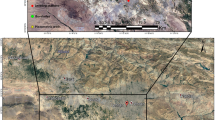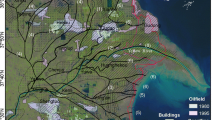Abstract
A large agricultural area located in 20 km north of the city of Mashhad in the north-east of Iran is subject to land subsidence. The subsidence rate was achieved in a couple of sparse points by precise leveling between 1995 and 2005, and continuous GPS measurements obtained from 2005 to 2006. In order to study the temporal behavior of the deformation in high spatial resolution, the small baseline subset (SBAS) algorithm was used to generate the interferometric SAR time series analysis. Time series analysis was performed using 19 interferograms calculated from 12 ENVISAT ASAR data spanning between 2003 and 2006. The time series results exhibited that the area is subsiding continuously without a significant seasonal effect. Mean LOS deformation velocity map obtained from time series analysis demonstrated a considerable subsidence rate up to 24 (cm/yr). In order to evaluate the time series analysis results, continuous GPS measurements as a geodetic approach were applied. The comparisons showed a great agreement between interferometry results and geodetic technique. Moreover, the information of various piezometric wells distributed in the area corresponding to 1995 to 2005 showed a significant decline in water table up to 20 meters. The correlation between the piezometric information and the surface deformation at well’s locations showed that the subsidence occurrence in Mashhad is due to the excess groundwater withdrawal.
Similar content being viewed by others
References
Amelung F, Galloway DL, Bell JW, Zebker HA and Laczniak RJ (1999) Sensing the ups and downs of Las Vegas: InSAR reveals structural control of land subsidence and aquifer system deformation. Geology 27(6):483–486
Bawden GW, Thatcher W, Stein RS, Hudnut KW and Peltzer G (2001) Tectonic contraction across Los Angeles after removal of groundwater pumping effects. Nature 412:812–815
Berardino P, Fornaro G, Lanari R and Sansosti E (2002) A New Algorithm for Surface Deformation Monitoring Based on Small Baseline Differential SAR Interferograms. IEEE Trans. on Geoscience and Remote Sensing 40:2375–2383
Biggs J and Wright T (2004) Creating a time series of ground deformation using InSAR. Scientific report, Department of Earth Science, University of Oxford
Crosetto M, Tscherning CC, Crippa B and Castillo M (2002) Subsidence monitoring using SAR interferometry: Reduction of the atmospheric effects using stochastic filtering. Geophysical Research Letters 29(9):26-1–26-4
Daniel RC, Maisons C, Carnec S, Mouelic L, King C and Hosford S (2003) Monitoring of slow ground deformation by ERS radar interferometry on the Vauvert salt mine (France) Comparison with groundbased measurement. Remote Sensing of Environment 88:468–478
Fialko Y and Simons M (2000) Deformation and seismocity in the Coso geothermal area, Inyo County, California: Observations and modeling using satellite radar interferometry, published in JGR, 105(21):781–21
Fruneau B and Sarti F (2000) Detection of ground subsidence in the city of Paris using radar interferometry: Isolation from atmospheric artefacts using correlation. Geophysical Research Letters 27(24): 3981–3984
Lanari R, Lundgren P, Manzo M and Casu F (2004) Satellite radar interferometry time series analysis of surface deformation for Los Angeles, California, Geophysical Research Letters, 31, doi:10.1029/2004GL021294
Massonnet D and Feigl KL (1998) Radar interferometry and its application to changes in the Earth’s surface. Reviews of Geophysics 36: 441–500
Mogi K (1958) Relations between the eruptions of various volcanoes and the deformations of the ground surfaces around them. Bulletin of the Earthquake Research Institute 36: 99–134
Okada Y (1985) Surface Deformation due to Shear and Tensile Faults in a Half-Space. Bulletin of the Seismological Society of America 75: 1135–1154
Schmidt DA and Burgman R (2003) Time-dependent land uplift and subsidence in the Santa Clara valley, California, from a large interferometric, synthetic aperture radar dataset. Journal of Geophysical Research 108: 8534–8543
Strozzi T, Wegmüller U, Tosi L, Bitelli G and Spreckels V (2001) Land subsidence monitoring with differential SAR interferometry. Photogramm. Engg. and Remote Sensing 67(11):1261–1270
Tesauro M, Beradino P, Lanari R, Sansoti E, Fornaro G, and Franceschetti G (2000) Urban subsidence inside the City of Napoli (Italy) observed with synthetic aperture radar interferometry at Campi Flegrei caldera. J. Geophys. Res. 106: 19,355–19,366
Yang X-M, Davis PM and Dieterich JH (1988) Deformation from inflation of a dipping finite prolate spheroid in an elastic half-space as a model for volcanic stressing. Journal of Geophysical Research, 93: 4249–4257
Author information
Authors and Affiliations
Corresponding author
About this article
Cite this article
Dehghani, M., Zoej, M.J.V., Saatchi, S. et al. Radar interferometry time series analysis of Mashhad subsidence. J Indian Soc Remote Sens 37, 147–156 (2009). https://doi.org/10.1007/s12524-009-0006-x
Received:
Accepted:
Published:
Issue Date:
DOI: https://doi.org/10.1007/s12524-009-0006-x




